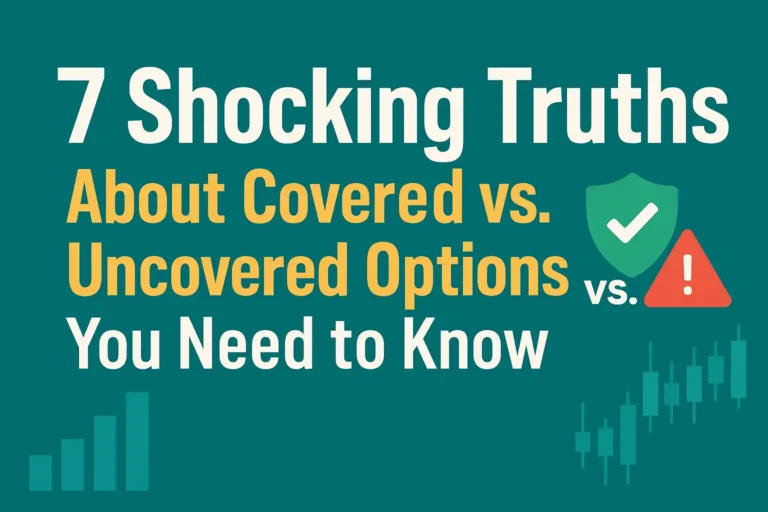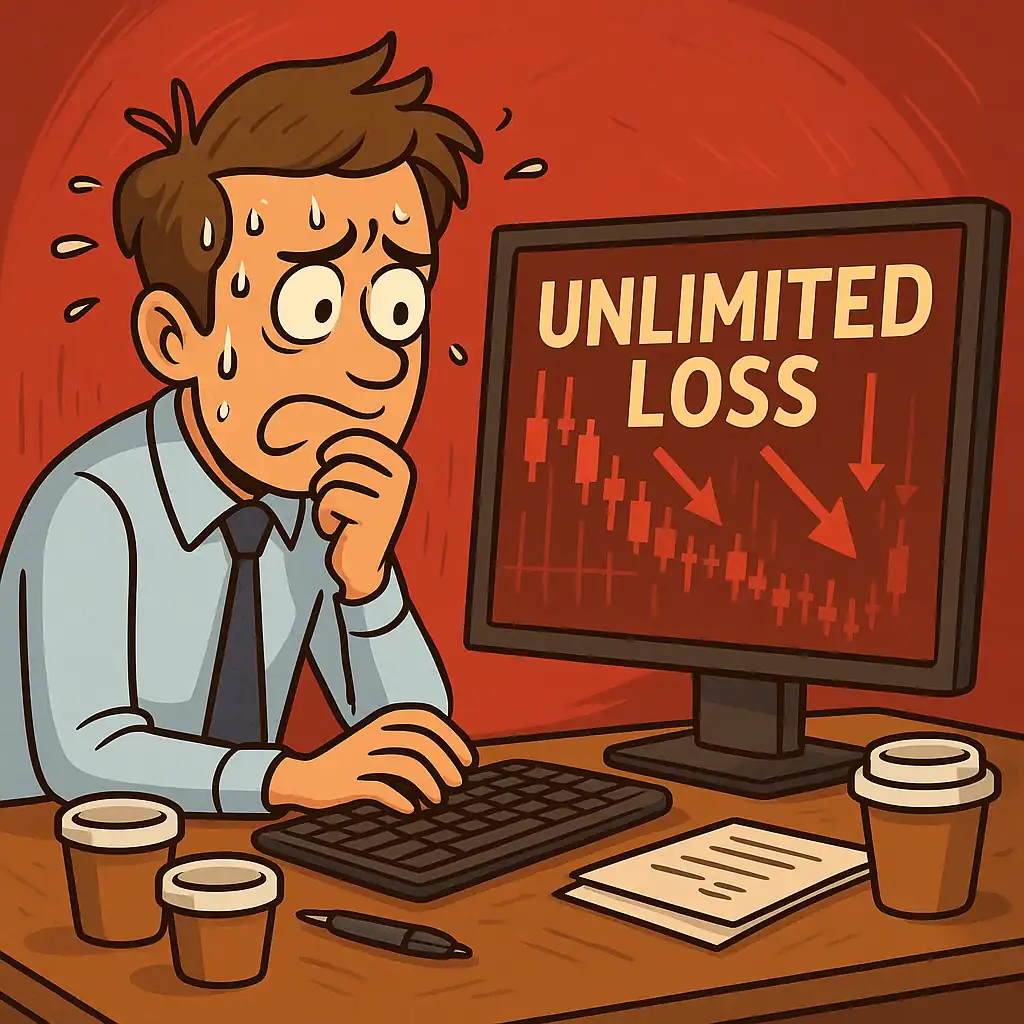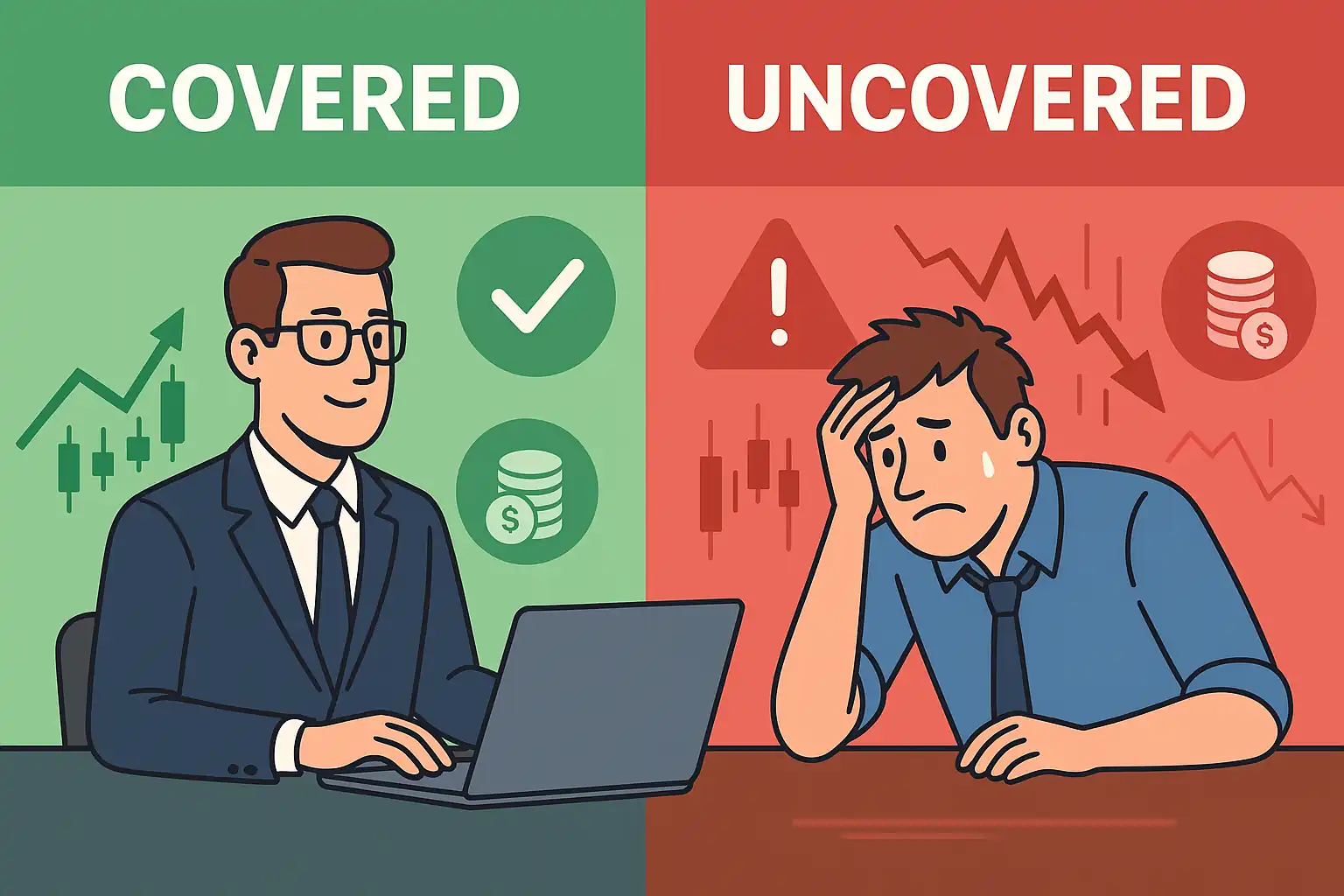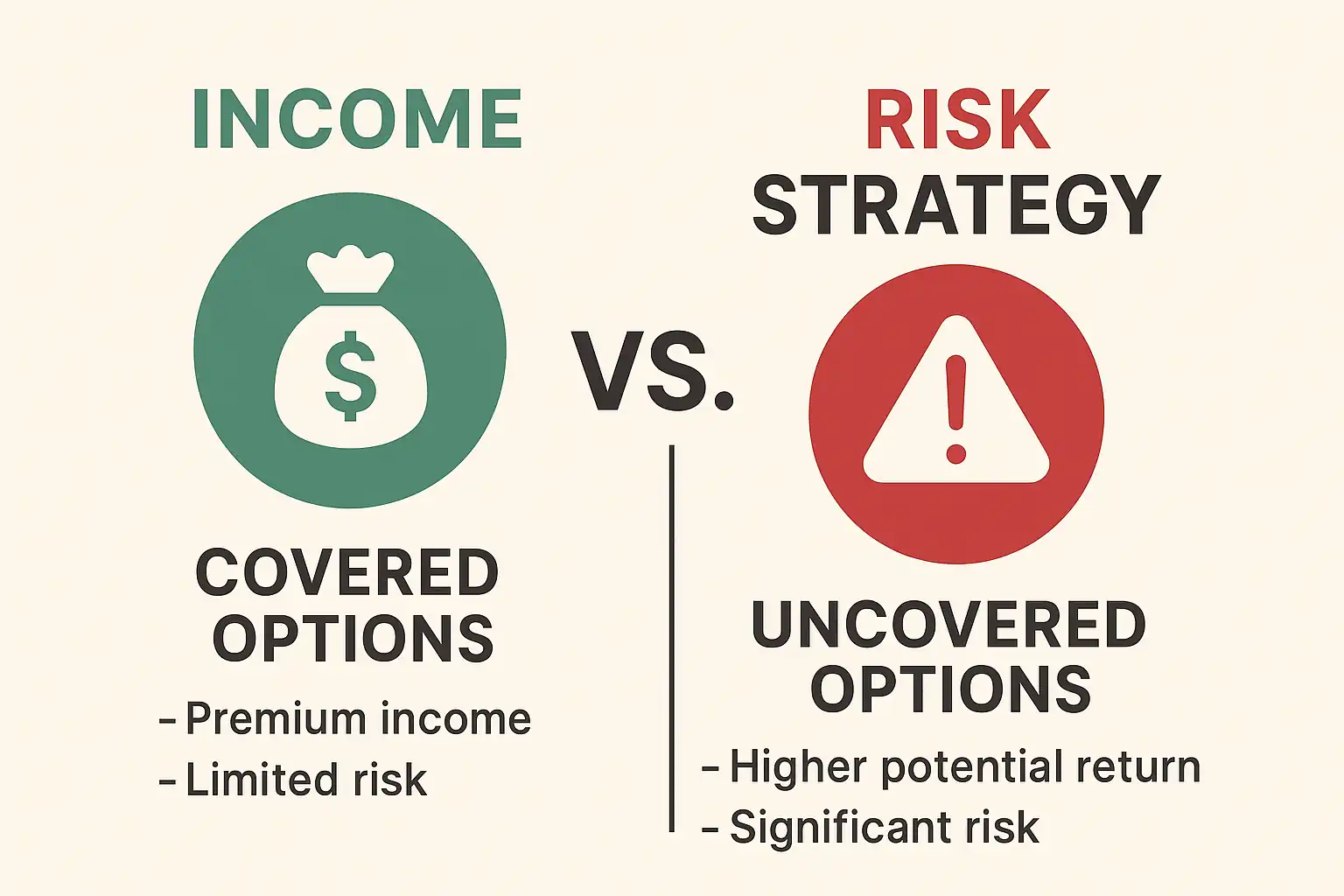
7 Shocking Truths About Covered vs. Uncovered Options You Need to Know
Covered vs. Uncovered Options
1. The Illusion of Safety in Covered Calls
Covered calls are often praised as the perfect “safe” options strategy — a way to generate income while still owning a stock you believe in. But here’s the shocking truth:
At first glance, covered calls offer everything traders love:
- ✔ Recurring income through premium collection
- ✔ Some downside cushion
- ✔ Ownership of the underlying stock
But here’s what most courses and YouTubers won’t tell you:
Covered calls can seriously limit your upside potential. If the underlying stock surges, you miss out on all gains above the strike price. That means while your stock rockets, you’re stuck collecting pennies in comparison.
⚠ Real Risk: Assignment
When you sell a call, you are agreeing to sell your stock at a predetermined price. If the stock hits that strike price, the buyer will exercise their right — and you’re forced to sell, even if the stock keeps rising.
This turns your “safe income play” into a regretful lost opportunity.
📈 Real-World Example
Imagine owning NVIDIA at $480 and selling a covered call with a $500 strike. The stock jumps to $560 before expiration. You’ve made a small profit — but the rest of the gains? Gone.
That’s exactly what happened to one of our readers. Learn more about why covered call setups often fail for beginners and what alternatives can work better. :contentReference[oaicite:0]{index=0}
🧠 Expert Opinion
“Covered calls work best in sideways markets. When trends break out, you’re holding dead weight.”
— Cory Mitchell, Chartered Market Technician
📌 What Most Traders Miss
- ✔ Assignment can happen early — especially before ex-dividend dates
- ✔ Tax consequences on short-term gains can reduce real profits
- ✔ Portfolio drag if overused in growth stock scenarios
🔥 Don’t Fall for the Hype
Many retail traders are taught to use covered calls as “renting out your stocks.” That’s true — but only when the market doesn’t move aggressively. In strong bull runs, you’ll feel the pain of capped gains.
Before jumping in, make sure your strategy aligns with the market and your investing foundation. :contentReference[oaicite:1]{index=1}
✅ Key Takeaway:
- Covered calls are not risk-free. They trade upside potential for modest income.
- Use in flat or range-bound markets — not in volatile bull runs.
- Protect yourself from assignment surprises with rolling tactics.
2. Uncovered Calls: A Recipe for Disaster—or Reward?

Uncovered calls—also known as naked calls—are the high-wire act of the options world. They promise rapid profit but come with a terrifying tradeoff: unlimited loss potential.
Here’s the raw truth: when you sell a naked call, you don’t own the underlying stock. If the stock price explodes beyond the strike, you’ll be forced to buy it at market price and sell at a lower one, taking the full brunt of the loss.
📉 Real Risk Scenario
Imagine selling an uncovered call on GameStop at a $22 strike, only for it to skyrocket to $140. Your losses? Virtually unlimited.
🔍 Why It’s Dangerous
- ❌ You’re exposed to an unlimited loss curve
- ❌ Most brokers restrict it to experienced, high-net-worth traders
- ❌ Not allowed in most retirement accounts due to risk exposure
✅ But There Are Pros (If You Know What You’re Doing)
- ✔ Fast income in sideways or bearish markets
- ✔ Minimal capital required upfront
Want to know why some traders get crushed by restrictions before they even begin? Explore our breakdown on why some brokers don’t allow hedging. :contentReference[oaicite:0]{index=0}
📘 Expert Take
“Naked calls should be used only by traders who can monitor the position every minute and who can handle margin calls at 3AM.”
— Jason Brown, Certified Options Coach
New traders often get lured in by the fast cash mindset. But without a stop-loss, a breakout can end your trading career in one session.
🔗 Further Reading
✅ Key Takeaway:
- Uncovered calls are not for beginners. They demand deep technical knowledge and risk control tools.
- If you’re not prepared to hedge or monitor 24/7, stay out.
3. Real Case Study: How One Trader Lost $10K on an Uncovered Play
Uncovered calls can be brutally unforgiving — and no one knows this better than Derek R. from Michigan, a self-taught trader who learned the hard way.
📉 What Happened
Derek sold 10 uncovered call options on Tesla ($TSLA) at a $265 strike, expecting the stock to stay flat ahead of its quarterly earnings. With premiums offering $3.40 per contract, he saw a chance for “easy” money — $3,400 if they expired worthless.
But then…
- 🚀 Tesla blew past earnings estimates
- 💥 Stock gapped up to $296 pre-market
- 🔻 Derek’s brokerage forced him to cover — at a $10,200 net loss
🔎 The Psychology Trap
He fell into a common trap: selling naked calls based on false confidence and incomplete risk assessment. Many beginner traders underestimate how fast the market can move — especially on volatile stocks like Tesla, Nvidia, or meme stocks.
Here’s where Derek made mistakes:
- ❌ Didn’t check implied volatility
- ❌ No stop-loss in place
- ❌ Didn’t calculate max loss exposure
- ❌ Ignored earnings week volatility
🧠 Expert Advice
“If you’re not using a calculated stop on naked calls, you’re trading with a loaded gun.”
— Matt Choi, CMT and Founder of Certus Trading
🔁 What Could He Have Done Instead?
- ✔ Used a bull call spread to cap losses
- ✔ Waited until after earnings to sell premiums
- ✔ Traded liquid ETFs like SPY instead of high-Beta stocks
Risk happens fast in options. That’s why many traders in our swing trading chat room:contentReference[oaicite:0]{index=0} share stories like Derek’s — not to scare, but to educate and warn others.
✅ Key Takeaway:
- Uncovered options should never be traded without a plan for max loss.
- Earnings weeks are notorious for high volatility — avoid naked calls during them.
- Use protective legs like spreads or collars to control risk.
Join the discussion in our free Swing Trading Chat Room and learn from real traders navigating these same challenges. :contentReference[oaicite:1]{index=1}
4. Expert Analysis: Covered vs. Naked—Which is Right for You?

Not all traders are created equal, and neither are options strategies. Whether you choose covered or uncovered calls largely depends on your risk tolerance, market outlook, and experience level.
👨🏫 What the Experts Say
“If you want controlled exposure, go covered. If you want to gamble, go naked.”
— Dr. Alexander Elder, Trading Psychologist and Author of *The New Trading for a Living*
Covered calls are ideal for conservative investors who want to extract extra returns from stocks they already own. Naked calls, on the other hand, are for aggressive traders looking to capitalize on short-term moves — with all the risk that entails.
🔍 Strategy Personality Fit
| Feature | Covered Calls | Uncovered (Naked) Calls |
|---|---|---|
| Risk Tolerance | Low to Medium | Very High |
| Capital Required | Own underlying stock | None (but margin is required) |
| Profit Potential | Limited | Theoretically unlimited |
| Best In | Sideways to mildly bullish markets | Strong conviction, bearish or neutral moves |
📚 Education Matters
If you’re still unclear which fits your style, visit the CBOE Options Education Center — one of the best free resources for traders (dofollow).
Want the government’s take on options risk? Read the SEC’s official options guide for retail investors (nofollow).
✅ Internal Resources to Help You Decide
Still debating between aggressive and conservative trading paths? Explore our internal breakdown of day trading vs. swing trading strategies to see which matches your tempo. :contentReference[oaicite:0]{index=0}
✅ Key Takeaway:
- If you need stability, stick with covered calls on long-term holdings.
- If you’re chasing returns with high tolerance for volatility, naked calls might work — but only with ironclad risk controls.
- Educate before you speculate — strategy without knowledge is gambling.
5. Pros and Cons You Didn’t Expect
Everyone talks about how covered calls are “safe” and naked calls are “risky”—but what you rarely hear are the nuanced pros and cons that could make or break your trades.
📊 Covered Calls: The Hidden Trade-Offs
- ✅ Generates income during sideways or slow bullish markets
- ✅ Lowers volatility of your portfolio
- ❌ Caps your profit if the stock soars
- ❌ Risk of early assignment, especially around dividends
They’re great in theory, but what if your stock is the next NVIDIA? You’re essentially “renting it out” at a discount to its future growth.
Explore how long-term stock ownership can impact your option strategies with our article on the ownership mindset in stock trading. :contentReference[oaicite:0]{index=0}
⚡ Uncovered (Naked) Calls: Are You Ready for These?
- ✅ Quick income in short-term trades
- ✅ No capital tied up in owning the stock
- ❌ Theoretically unlimited losses
- ❌ Can’t be used in IRAs or retirement accounts
- ❌ May lead to a margin call in volatile markets
📌 Side-by-Side Summary Table
| Criteria | Covered Calls | Uncovered Calls |
|---|---|---|
| Income Potential | ✅ Moderate | ✅ High (but risky) |
| Capital Required | ✅ Must own stock | ❌ Margin required |
| Loss Potential | ❌ Limited (to downside in stock) | ❌ Unlimited |
| Best Used In | ✅ Sideways/Bullish markets | ✅ Neutral or Bearish predictions |
| Beginner-Friendly? | ✅ Yes | ❌ No |
✅ Key Takeaway:
- Covered calls are ideal for conservative traders aiming for stable income.
- Uncovered calls require advanced knowledge and discipline.
- Neither is perfect — choose based on your market outlook and risk appetite.
6. Strategy Showdown: Income vs. Risk

Every options trade is a balance between income and risk. What makes the difference? Your market outlook and risk capacity.
📈 Covered Calls: The Income Generator
Covered calls are designed to enhance returns from stocks you already own. If your portfolio includes dividend payers or blue-chip stocks, this is a powerful strategy.
- ✅ Monthly or weekly income
- ✅ Works well in slow-bull or sideways markets
- ❌ Limited upside if the stock breaks out
Best Use: Stocks like Pepsi, Microsoft, or JPMorgan — stable performers with low volatility.
⚡ Uncovered Calls: The Risk-Revenue Rocket
Uncovered (naked) calls offer high premiums but come with explosive risks. They are only suitable for traders who know how to hedge or close out fast.
- ✅ Larger premium capture
- ✅ Good for short-term neutral or bearish bets
- ❌ Huge losses if the stock surges
Best Use: Highly liquid stocks like AMD, SPY, or QQQ — but with a strong watch on earnings or macro events.
💡 Use Market Conditions to Choose
| Market Environment | Best Strategy |
|---|---|
| Flat or Range-Bound | ✅ Covered Calls |
| High Volatility / Earnings Weeks | ⚠ Only for advanced traders — Spreads or Hedged Naked Calls |
| Bullish Breakouts | ❌ Avoid Covered or Naked — Use Call Buying or Spreads |
🛡 Pro Tip: Use Hybrid Strategies
- ✔ Covered Call + Protective Put = “Collar Strategy” to limit downside
- ✔ Sell Uncovered Calls + Buy Higher Call = Bear Call Spread
Understand more about trader behavior and strategy application in our article on why owning stock changes how you trade options. :contentReference[oaicite:0]{index=0}
✅ Key Takeaway:
- Covered calls = low-risk, steady income, low volatility markets.
- Uncovered calls = high reward, high risk, fast action required.
- Smart traders use hybrid approaches to manage risk while capturing premium.
7. The Final Truth – Which One Wins in 2025 and Beyond?
So which is better — covered or uncovered calls? The answer isn’t universal. It depends on your goals, your risk limits, and the market environment you’re trading in.
📊 2025 Options Market Outlook
- ✔ Covered calls continue to dominate retirement and passive income portfolios
- ✔ Naked calls are increasingly scrutinized by brokers due to heightened volatility and regulatory risks
- ✔ Spreads and hybrid options strategies are now the go-to for smart retail and institutional traders
🚦 Covered Calls Win In…
- ✅ Tax-advantaged accounts like IRAs
- ✅ Markets moving sideways or slowly upward
- ✅ Dividend stock holdings
🔥 Naked Calls Work In…
- ✅ Short-term trades with strong bearish conviction
- ✅ High implied volatility with tight exits
- ✅ Accounts with risk hedges in place
🔄 Hybrid Strategy for Smart Traders
Use a **“covered call + protective put” combo** (also called a collar) to protect downside while still collecting premium. Or switch to **bear call spreads** instead of naked calls to define max risk.
Smart traders aren’t stuck in one style. They evolve — especially when volatility spikes, or Fed policy shifts.
📚 Reinforce Your Learning
Before you enter another trade, make sure you understand how AI is impacting stock behavior and alert systems. Strategy must evolve with the tools and trends. :contentReference[oaicite:0]{index=0}
Covered calls help you sleep at night. Uncovered calls keep you up pacing. Trade the one that fits your psychology — not just your portfolio.
✅ Key Takeaway:
- In 2025, covered calls remain the go-to strategy for consistent income.
- Uncovered calls offer profit potential—but only with aggressive risk control.
- Most success comes from strategic combos, not choosing sides blindly.
💡 Key Takeaways
Click to Reveal the Full Summary
- ✅ Covered calls are ideal for conservative traders seeking income with controlled risk.
- ❌ Uncovered calls offer high returns but come with the risk of unlimited losses.
- ✅ Covered calls fit best in sideways or slow bull markets, especially when tied to dividend stocks.
- ⚠ Naked calls require constant monitoring, tight exits, and iron discipline — not recommended for beginners.
- 🔄 The best traders use hybrid strategies like collars and spreads to balance income and risk.
- 📈 Your strategy must evolve with the market — and with your personal psychology and capital resources.
🔗 Trusted External Resources
Get direct guidance from the Chicago Board Options Exchange — the original authority in U.S. options trading.
Educational resources for all skill levels. Learn how to trade options with strategies, tools, and videos.
Understand the mechanics and risks of trading uncovered calls with beginner-friendly visuals and definitions.
The official SEC guide to options and the risks of covered and uncovered calls.